
Cryptomeria is a monotypic genus of conifer in the cypress family Cupressaceae. It includes only one species, Cryptomeria japonica. It used to be considered by some to be endemic to Japan, where it is known as Sugi. The tree is called Japanese cedar or Japanese redwood in English. It has been extensively introduced and cultivated for wood production on the Azores.
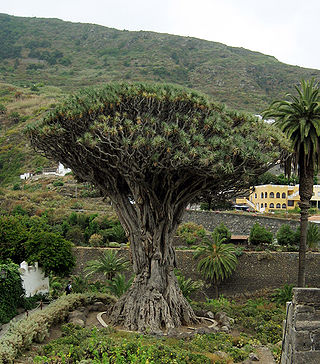
Dracaena draco, the Canary Islands dragon tree or drago, is a subtropical tree in the genus Dracaena, native to the Canary Islands, Cape Verde, Madeira, western Morocco, and possibly introduced into the Azores.

The Azores bullfinch, also known as the São Miguel bullfinch, or locally in Portuguese as the priolo, is a threatened passerine bird in the true finch family. It is endemic to São Miguel Island, in the Azores archipelago of Macaronesia in the North Atlantic Ocean.

Picconia is a genus of two species of flowering plants in the family Oleaceae, found in the laurel forests habitat of Macaronesia.

Juniperus brevifolia, the Azores juniper, is a species of juniper, endemic to the Azores, where it occurs at altitudes of 240–800 metres, rarely up to 1,500 m (4,900 ft). It is closely related to Juniperus oxycedrus of the Mediterranean region and Juniperus cedrus of the neighboring Macaronesian islands. It is threatened by habitat loss.

Laurus azorica, the Azores laurel or Macaronesian laurel, is a small, evergreen tree in the laurel family (Lauraceae), found only on the Azores island group in the North Atlantic.

Picconia excelsa is a species of Picconia, endemic to Macaronesia, occurring on the Canary Islands (Spain) and Madeira (Portugal).
Pico da Vara is the highest mountain on the island of São Miguel, in the Portuguese archipelago of the Azores, and principal special protection of the Nature Reserve of Pico da Vara. The area around the mountain includes the largest remaining stand of the native laurisilva forest on the island, home to the critically endangered endemic Azores bullfinch.

The Recreational Forest Reserve of Valverde is a recreational forest located centrally on the island of Santa Maria, in the civil parish of Vila do Porto, municipality of Vila do Porto in the Portuguese archipelago of the Azores.

The Recreational Forest Reserve of Fontinhas is a recreational forest located centrally on the island of Santa Maria, in the civil parish of Santo Espírito, municipality of Vila do Porto in the Portuguese archipelago of the Azores.

Pseudanchomenus is a beetle genus in the family of ground beetles (Carabidae). Its only described species, Pseudanchomenus aptinoides, is endemic to the Azores archipelago.
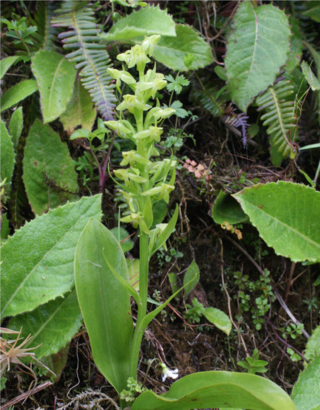
Platanthera azorica, commonly known as Hochstetter's butterfly orchid, is a species of orchid in the genus Platanthera. It was "rediscovered" in 2011 on a single volcanic ridge on the central Azores island of São Jorge, and "is arguably Europe's rarest bona fide orchid species." While P. azorica was previously considered by some sources to be the same as Platanthera micrantha, the 2011 discovery triggered a thorough analysis of historic and current data and specimens, resulting in three species identified.

Hypericum foliosum, the shining St John's wort, is a species of flowering plant in the family Hypericaceae. It is a bushy shrub endemic to the Portuguese Azores Islands with golden yellow petals and many stems. The species was described by William Aiton in 1789 and was later placed into section Androsaemum of the genus Hypericum by Norman Robson in 1984. It has a diverse essential oil profile made up mostly of monoterpene hydrocarbons, and significant concentrations of various medicinally useful phenols and carotenoids. Populations of the plant are small in number, but quick to colonize cleared areas like groves, landslide areas, and volcanic ash deposits. It is parasitized by fungus and by moth species, but is not considered endangered by the IUCN. H. foliosum is used in traditional medicine on the Azores for diuretic, hepatoprotective, and antihypertensive purposes. It also has in vitro antibiotic and antioxidizing capabilities.

The Azores temperate mixed forests is a temperate broadleaf and mixed forests ecoregion of southwestern Europe. It encompasses the Azores archipelago in the Atlantic Ocean. These volcanic islands are an autonomous region of Portugal, and lie 1500 km west of the Portuguese mainland.

Baixo Islet, also known locally as Ilhéu do Carapacho and historically as Ilhéu dos Homiziados, is a small uninhabited islet group located off the southeast coast of the island of Graciosa in the Portuguese archipelago of the Azores. Along with Praia Islet to its north, Baixo Islet is one of two main breeding places of Monteiro's storm petrel, an endemic marine bird of the Azores.
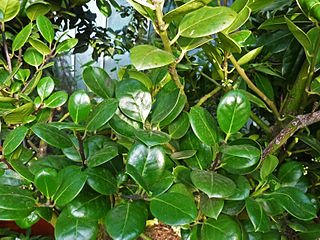
Ilex perado, the Macaronesian holly, is a species of holly endemic to Macaronesia, distributed throughout the Azores, Madeira and Canary islands. It is an important component of the natural high-altitude Macaronesian rainforest, known as 'laurisilva', found mostly at 500 to 1,200 m altitude but it also appears in forest formations at lower elevation. Many of the subspecies have been classified as threatened, probably because of very small population sizes, and are protected by local, national and regional legislation.

Viburnum treleasei, the Azorean laurustinus, is a species in the genus Viburnum endemic to the Azores. It inhabits natural forests of Juniperus brevifolia, Laurus azorica and Ilex perado, Erica azorica, in sloping areas. Generally at altitudes above 200 m (660 ft). It is present in eight of the nine islands.
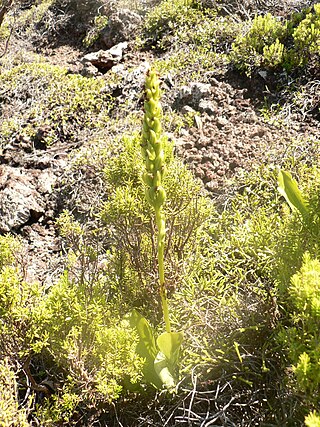
Platanthera micrantha or the narrow-lipped butterfly orchid is a species of orchid in the genus Platanthera endemic to the Azores. It is an endangered species and is closely related to P. azorica and P. pollostantha, also endemic to the Azores.
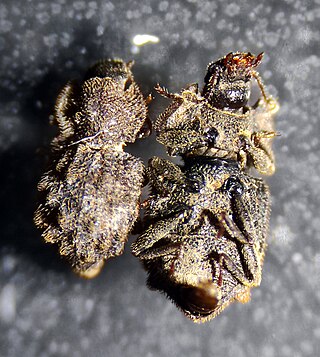
Tarphius floresensis is a beetle species in the family Zopheridae endemic to Flores Island (Azores). It is commonly named as an iron-clad beetle in English or Escaravelho-cascudo-da-mata in Portuguese. The genus Tarphius is evolutionarily old species to Azores.

Trechus terrabravensis is a beetle species in the family Carabidae endemic to Terceira Island, Azores, Portugal.



















